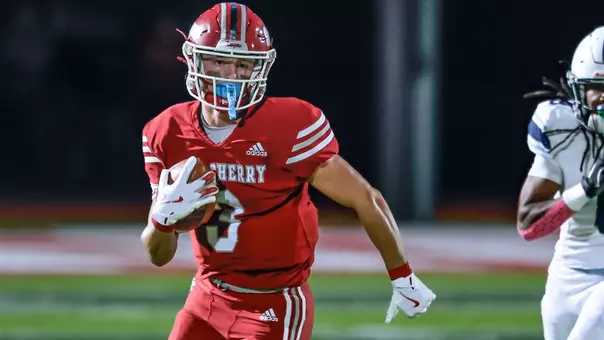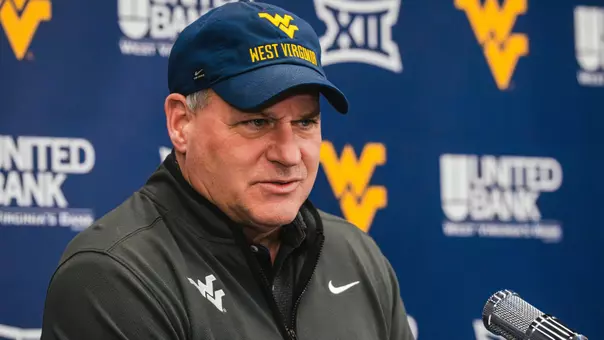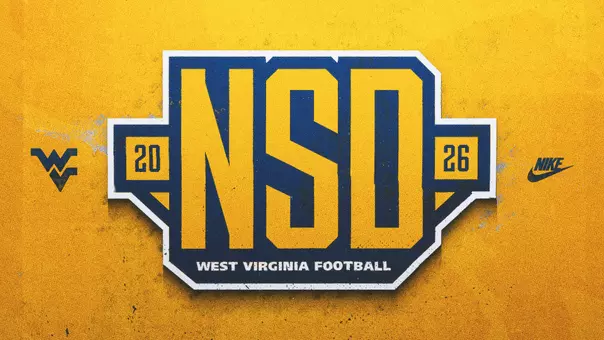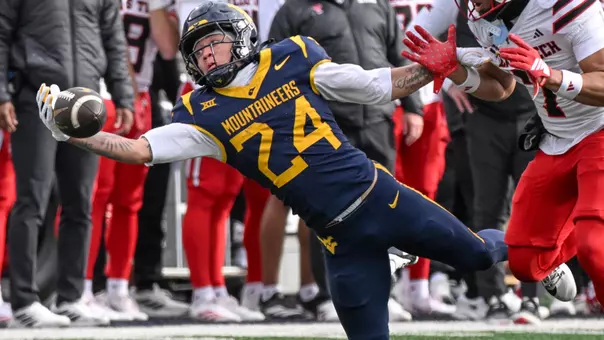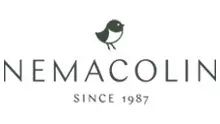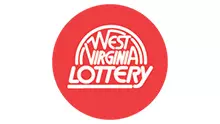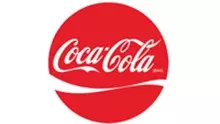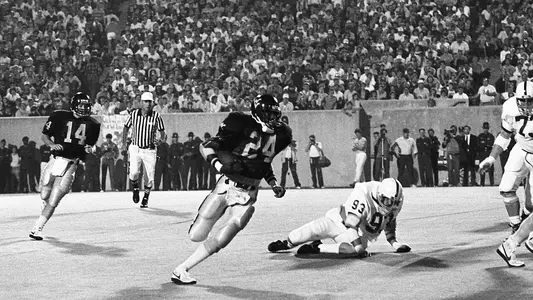
Photo by: WVU Athletic Communications
Mountaineer Football After Dark Dates Back to 1930
September 05, 2024 01:35 PM | Football, Blog
MORGANTOWN, W.Va. – In early August, West Virginia University announced new lighting upgrades to Milan Puskar Stadium that will bring the 44-year-old edifice out of the dark ages.
Well, not really, but the state-of-the-art LED lighting system designed by Musco Lighting marks a major upgrade to the stadium's lighting capacity.
Saturday's UAlbany game will be the first time fans get an opportunity to watch the Mountaineers play under the new lights, which coach Neal Brown says are a significant improvement.
A 6 p.m. start time has been assigned for the game.
Lights have been an integral part of Milan Puskar Stadium since 1983 and were first used in the 1984 season opener against Ohio University when the facility was still known as Mountaineer Field.
The '84 opener was originally supposed to start at 12:20, in accordance with all home games that year, but the decision was made to push back the starting time to 5 p.m. to avoid the heat of an early September afternoon start.
At least that was the reasoning provided to the media.
Ohio University football coach Brian Burke was not sold on that explanation, however.
"I was never consulted on it, but it's their home game, and they don't owe me any courtesy," he said. "But if they say it's for humanitarian reasons like the heat, then they should have asked me. We're the guys getting beat on.
"I don't think playing the game in the late afternoon will make much difference in avoiding the heat," he continued. "You're only talking about five or six degrees. I think they (WVU) just want to try out their lights. I'm thinking about that three-hour bus ride home. I'd rather get back at 12 instead of 3 in the morning."
Burke, whose Ohio U. team lost 55-3 to West Virginia the year prior, joked, "Maybe they just won't turn the lights on, and we can hide in the second half."
His players didn't just hide in the second half – they hid the entire game – falling 38-0.
And while technically not the first night game ever played at Milan Puskar Stadium because of the 5 p.m. start time, it was the first time the lights were ever turned on.
The lights were also on for West Virginia's come-from-behind victory over fourth-ranked Boston College on Oct. 20, but the first official night game at home was a week later against Penn State on Oct. 27.
ESPN, then relatively new to college football, televised the contest and the kickoff was switched to 7:45 p.m. Jim Simpson and Paul Maguire handled the announcing duties for the fledgling network.
West Virginia won the contest 17-14.
As for WVU's first-ever night football game, that requires a little more digging.
For years, it was thought to have been played at old Griffith Stadium in Washington, D.C., on Friday, Oct. 25, 1940, against George Washington University.
The Colonials used Griffith Stadium as its home from 1930 until 1960, and frequently played their home football games there on Friday nights when the Washington Senators were out of town. Senators owner Clark Griffith was accommodating to GW because his son, Calvin, once played basketball and baseball for the Colonials in the mid-1930s.
West Virginia also frequently played Friday night games under the lights against Temple in the 1930s and 1940s at Temple Stadium.
On Friday, Oct. 23, 1931, West Virginia played a night game at Detroit University's 25,000-seat Dinan Field, and the Titans came away with a 9-7 victory. The Mountaineers also faced the Titans at Dinan Field on Friday, Oct. 17, 1930, one week prior to playing Georgetown on a Friday night at Griffin Stadium.
But that was not the Mountaineers' first foray under the lights.
That occurred on Friday, Sept. 19, 1930, at Forbes Field in Pittsburgh when the Mountaineers opened their season against Duquesne.
Forbes Field, home to the Pittsburgh Pirates and Pittsburgh Steelers, was also used by Pitt's football team from 1909 until 1924 when Pitt Stadium officially opened. Duquesne began using Forbes Field in the late 1920s when coach Elmer Layden elevated the status of Duquesne football in the region.
The WVU-Duquesne game, which kicked off at 8:45 p.m., took on a carnival-like atmosphere, as described by the Pittsburgh Post-Gazette in its morning edition:
"Blaring student bands of both institutions will afford the customary musical side attractions, and the leather lunged cheerleaders will prance back into prominence, but the fact that the game is an after-dark encounter as well as a meeting between two evenly matched antagonists furnished the unusual in the great American game."
And the Pittsburgh Sun-Telegraph's Jess Carver wrote afterward:
"Under the glare of the lights at Forbes Field last night, before a vociferous crowd of 25,000, West Virginia University turned aside the long-interrupted parade of Duquesne University, sidetracking Elmer Layden's Night Riders with a 7-0 defeat.
"The contest, attracting as it did, the largest crowd that has seen West Virginia perform in years, was a bitterly fought affair."
The game's only touchdown was scored by Morgantown's Bill Parriott in the second quarter on a 3-yard run. Parriott also kicked the conversion point.
Neither team could muster much offensively, Duquesne holding a 10-to-7 advantage in first downs and a 139-to-100 edge on the ground, but WVU's four completed passes for 54 yards were enough to put the Mountaineers in position to score.
Perhaps the Dukes' defenders had a tough time locating the football under the lights?
Rat Rodgers was West Virginia's coach that year, his last leading the Mountaineers. Earle "Greasy" Neale was brought in to replace Rodgers at the conclusion of the season.
One other interesting sidenote to the game - starting Duquesne right tackle Ray Kemp was the biggest player on the field that evening, checking in at a hefty 205 pounds, though the average weight actually favored West Virginia 179 pounds to 174 pounds.
A West Virginia game played against Kentucky on Nov. 4, 1905, at the old Athletic Field on campus also required some artificial illumination.
As the story goes, the Wildcats were tardy arriving to Morgantown and when the contest stretched into the late afternoon hours, it was said that motorcars were turned on to shine enough light on the field for the Mountaineers to complete their 45-0 victory.
So, for the sticklers out there, you can put an asterisk next to the 1930 WVU-Duquesne game.
Well, not really, but the state-of-the-art LED lighting system designed by Musco Lighting marks a major upgrade to the stadium's lighting capacity.
Saturday's UAlbany game will be the first time fans get an opportunity to watch the Mountaineers play under the new lights, which coach Neal Brown says are a significant improvement.
A 6 p.m. start time has been assigned for the game.
Lights have been an integral part of Milan Puskar Stadium since 1983 and were first used in the 1984 season opener against Ohio University when the facility was still known as Mountaineer Field.
The '84 opener was originally supposed to start at 12:20, in accordance with all home games that year, but the decision was made to push back the starting time to 5 p.m. to avoid the heat of an early September afternoon start.
At least that was the reasoning provided to the media.
Ohio University football coach Brian Burke was not sold on that explanation, however.
"I was never consulted on it, but it's their home game, and they don't owe me any courtesy," he said. "But if they say it's for humanitarian reasons like the heat, then they should have asked me. We're the guys getting beat on.
"I don't think playing the game in the late afternoon will make much difference in avoiding the heat," he continued. "You're only talking about five or six degrees. I think they (WVU) just want to try out their lights. I'm thinking about that three-hour bus ride home. I'd rather get back at 12 instead of 3 in the morning."
Burke, whose Ohio U. team lost 55-3 to West Virginia the year prior, joked, "Maybe they just won't turn the lights on, and we can hide in the second half."
His players didn't just hide in the second half – they hid the entire game – falling 38-0.
And while technically not the first night game ever played at Milan Puskar Stadium because of the 5 p.m. start time, it was the first time the lights were ever turned on.
The lights were also on for West Virginia's come-from-behind victory over fourth-ranked Boston College on Oct. 20, but the first official night game at home was a week later against Penn State on Oct. 27.
ESPN, then relatively new to college football, televised the contest and the kickoff was switched to 7:45 p.m. Jim Simpson and Paul Maguire handled the announcing duties for the fledgling network.
West Virginia won the contest 17-14.
As for WVU's first-ever night football game, that requires a little more digging.
For years, it was thought to have been played at old Griffith Stadium in Washington, D.C., on Friday, Oct. 25, 1940, against George Washington University.
The Colonials used Griffith Stadium as its home from 1930 until 1960, and frequently played their home football games there on Friday nights when the Washington Senators were out of town. Senators owner Clark Griffith was accommodating to GW because his son, Calvin, once played basketball and baseball for the Colonials in the mid-1930s.
West Virginia also frequently played Friday night games under the lights against Temple in the 1930s and 1940s at Temple Stadium.
On Friday, Oct. 23, 1931, West Virginia played a night game at Detroit University's 25,000-seat Dinan Field, and the Titans came away with a 9-7 victory. The Mountaineers also faced the Titans at Dinan Field on Friday, Oct. 17, 1930, one week prior to playing Georgetown on a Friday night at Griffin Stadium.
But that was not the Mountaineers' first foray under the lights.
That occurred on Friday, Sept. 19, 1930, at Forbes Field in Pittsburgh when the Mountaineers opened their season against Duquesne.
Forbes Field, home to the Pittsburgh Pirates and Pittsburgh Steelers, was also used by Pitt's football team from 1909 until 1924 when Pitt Stadium officially opened. Duquesne began using Forbes Field in the late 1920s when coach Elmer Layden elevated the status of Duquesne football in the region.
The WVU-Duquesne game, which kicked off at 8:45 p.m., took on a carnival-like atmosphere, as described by the Pittsburgh Post-Gazette in its morning edition:
"Blaring student bands of both institutions will afford the customary musical side attractions, and the leather lunged cheerleaders will prance back into prominence, but the fact that the game is an after-dark encounter as well as a meeting between two evenly matched antagonists furnished the unusual in the great American game."
And the Pittsburgh Sun-Telegraph's Jess Carver wrote afterward:
"Under the glare of the lights at Forbes Field last night, before a vociferous crowd of 25,000, West Virginia University turned aside the long-interrupted parade of Duquesne University, sidetracking Elmer Layden's Night Riders with a 7-0 defeat.
"The contest, attracting as it did, the largest crowd that has seen West Virginia perform in years, was a bitterly fought affair."
The game's only touchdown was scored by Morgantown's Bill Parriott in the second quarter on a 3-yard run. Parriott also kicked the conversion point.
Neither team could muster much offensively, Duquesne holding a 10-to-7 advantage in first downs and a 139-to-100 edge on the ground, but WVU's four completed passes for 54 yards were enough to put the Mountaineers in position to score.
Perhaps the Dukes' defenders had a tough time locating the football under the lights?
Rat Rodgers was West Virginia's coach that year, his last leading the Mountaineers. Earle "Greasy" Neale was brought in to replace Rodgers at the conclusion of the season.
One other interesting sidenote to the game - starting Duquesne right tackle Ray Kemp was the biggest player on the field that evening, checking in at a hefty 205 pounds, though the average weight actually favored West Virginia 179 pounds to 174 pounds.
A West Virginia game played against Kentucky on Nov. 4, 1905, at the old Athletic Field on campus also required some artificial illumination.
As the story goes, the Wildcats were tardy arriving to Morgantown and when the contest stretched into the late afternoon hours, it was said that motorcars were turned on to shine enough light on the field for the Mountaineers to complete their 45-0 victory.
So, for the sticklers out there, you can put an asterisk next to the 1930 WVU-Duquesne game.
Mark Kellogg | Mercyhurst
Saturday, December 06
Sydney Shaw and Carter McCray | Mercyhurst
Saturday, December 06
Darius Wiley | NSD26
Saturday, December 06
United Bank Playbook: Wake Forest Preview
Friday, December 05
